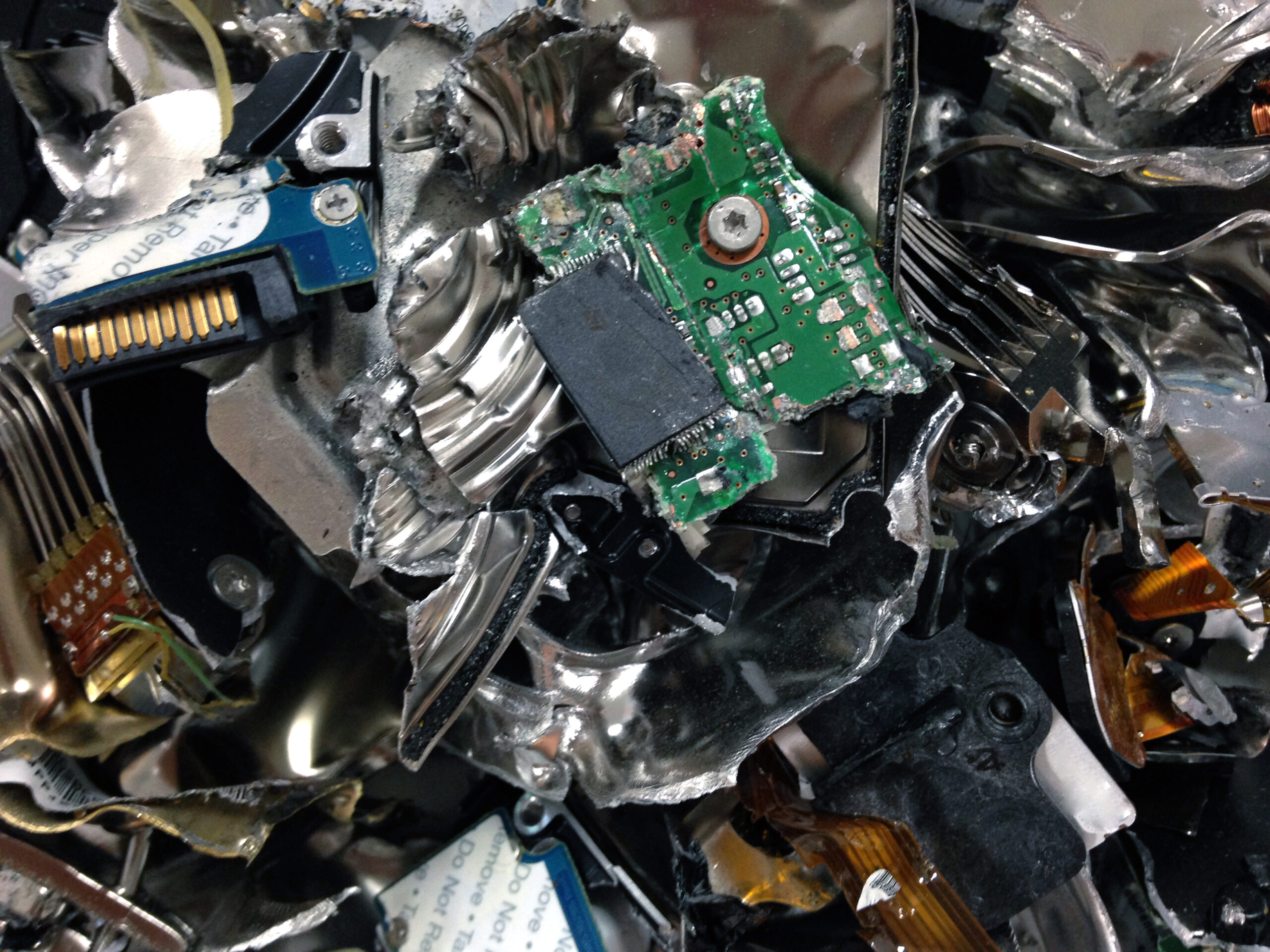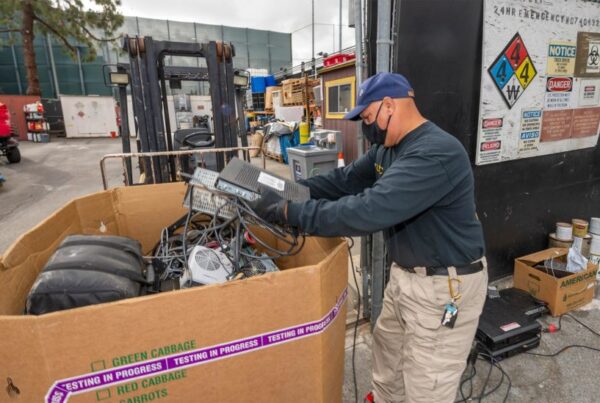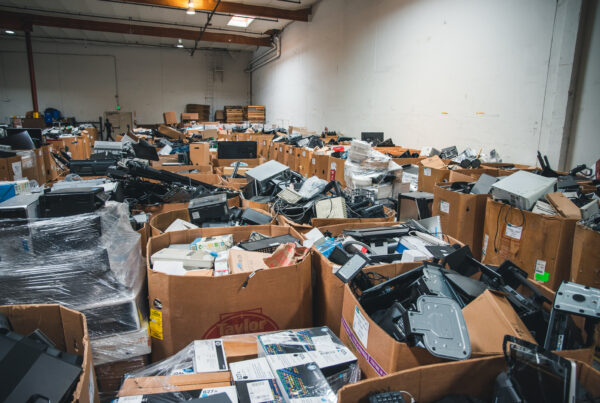Our old devices can be ticking time bombs of personal information. Imagine a curious security expert bought 41 used computers from stores, and shockingly, only two had been properly wiped clean. This eye-opening example shows just how vulnerable we are when we don’t do hard drive destruction properly. And it happens more often than you think.
Take Morgan Stanley, for example. In 2016, they were slapped with a massive $35 million fine for not properly getting rid of hard drives full of customer information. That’s a lot of money…even for them. This costly mistake serves as a wake-up call for everyone, from big corporations to everyday users.
Securely destroying or erasing hard drives protects finances, safeguards company secrets, and maintains customer trust. With stringent regulations like General Data Protection Regulation (GDPR) and HIPAA in place, businesses must prioritize data security. Some organizations take extreme precautions, destroying any drive that has ever contained their data, regardless of its current contents.
As we rely more and more on digital technology, the need for secure hard drive destruction grows. It’s the key to safeguarding our digital identities and maintaining the trust that keeps our connected world spinning. But how exactly can we make sure our digital footprints are truly erased when we say goodbye to our old devices?
Table of Contents
- Understanding Hard Drive Destruction
- The Top Methods for Hard Drive Destruction
- The Pros and Cons of Hard Drive Destruction
- Best Practices for Hard Drive Destruction
- Alternatives to Physical Hard Drive Destruction
- Donate Your Technology to Human-I-T and Enjoy Peace of Mind from Secure Hard Drive Destruction
Understanding Hard Drive Destruction
Hard drive destruction is a meticulous process designed to render data completely unreadable, using either physical methods like shredding or electronic techniques such as secure wiping. The goal is to thwart even the most advanced data recovery tools from reconstructing your digital information.
A lively debate persists in the tech world regarding the most effective approach to this process. Proponents of physical destruction advocate for literally crushing or shredding drives, claiming it’s the only foolproof method. In contrast, some IT professionals argue that proper software erasure, utilizing data wipe algorithms like DoD 5220.22-M, offers equal effectiveness with less waste. The dilemma lies in choosing between absolute certainty of data destruction, which often means rendering hardware unusable, and trusting software solutions that potentially allow devices a second life.
For many businesses, this decision extends into concerns of legal compliance. Many organizations require official certificates of destruction, not only for regulatory compliance but also to maintain valid insurance coverage. The stakes are high. Slip up on data security regulations, and a company could face hefty fines or legal trouble. More than protecting data, appropriate and ethical hard drive destruction protects the entire business from the public fallout of a potential breach.
No universal solution exists. The optimal method depends on factors such as data sensitivity, industry requirements, and specific device characteristics. Let’s explore the available options and evaluate their effectiveness in ensuring data security.
The Top Methods for Hard Drive Destruction
Physical Destruction Techniques
Shredding
Sometimes bigger isn’t better when it comes to data destruction. Industrial shredders slice hard drives into pieces as small as 2mm. These machines turn your old tech into confetti, leaving no byte unturned. Many experts consider this method the Fort Knox of data destruction. It’s hard to argue with a drive reduced to metal flakes.
Crushing
If shredding seems too delicate, crushing might be your style. Specialized crushers, like those from eDR Solutions, bring the hammer down – literally. These machines apply a whopping 7,500 pounds of force to drives. One punch is all it takes to render a drive useless and its data irretrievable.
Disintegration
For the truly paranoid (or those with top-secret data), there’s disintegration. This method uses a conveyor system to feed drives into a knife-wielding disintegrator. This heavy-duty approach requires special power and ventilation setups. It’s the go-to choice for handling classified information.
Drilling
Not every method requires industrial-grade equipment. Some IT pros prefer a hands-on approach with drill presses. They target key areas like the motor, controller board, and platter. While it’s less secure than other methods, it can be done in-house on a budget.
Data Sanitization Methods
Degaussing
Moving into the digital realm, degaussing uses powerful magnets to scramble data. Affordable degaussers start at a few hundred dollars, making it accessible for many businesses. However, this method only works on magnetic HDDs, not modern SSDs. It’s effective, but not a one-size-fits-all solution.
Secure Erasure
For a thorough digital scrubbing, secure erasure follows strict standards like NIST 800-88. Popular tools like DBAN and Blancco Drive Eraser dig deep to purge every last bit of data. SSDs require special firmware-based commands for a proper wipe.
Cryptographic Erasure
The most modern approach, cryptographic erasure, is all about smart deletion. This method encrypts entire drives, then destroys the encryption key. Some IT pros use tools like BitLocker before a factory reset. When using FIPS-validated modules, it’s considered highly secure.
Each method offers a unique approach to data destruction. Some rely on brute force, while others use clever digital tactics. The choice depends on your security needs, budget, and hardware type. But with cybercriminals growing more sophisticated by the day, how do these methods measure up against evolving threats? Let’s weigh the pros and cons of each approach.
The Pros and Cons of Hard Drive Destruction
The Pros of Hard Drive Destruction
Physical destruction offers unparalleled certainty. Even the most advanced recovery techniques can’t resurrect data from metal confetti, providing priceless peace of mind for organizations handling sensitive information.
Across various industries, hard drive destruction meets stringent data handling requirements head-on. Government agencies adhere to rigorous NIST guidelines, while financial and educational institutions follow similar protocols. Certified destruction processes create an audit trail that satisfies regulators and serves as a safeguard during compliance checks.
For ultimate assurance, some companies opt for on-site destruction services. This approach brings the data elimination process directly to the client, eliminating any doubts about the fate of sensitive information.
The Cons of Hard Drive Destruction
Physical hard drive destruction comes with some notable drawbacks. The destruction of functional hardware exacerbates our growing e-waste problem, raising concerns among environmentally conscious IT professionals. This is notable because a recent study found that 70% of consumers consider a company’s sustainability efforts when making purchasing decisions. Destroying working hardware feels wasteful to many, especially when these drives could find new homes if their previous owners had practiced data sanitization instead of destroying them.
Financial considerations also play a role. Hard drive destruction equipment, such as industrial shredders and degaussers, comes with hefty price tags. For large organizations managing thousands of drives, these costs can escalate rapidly.
Best Practices for Hard Drive Destruction
Tailor Your Hard Drive Destruction Strategy to Your Business Needs
Data destruction strategies must be tailored to each organization’s unique needs. For highly sensitive information, physical destruction remains the gold standard. Less critical data might be adequately protected through secure digital erasure. Some companies opt for a comprehensive approach, combining digital wiping with physical destruction to ensure data is thoroughly eliminated.
Implement a Chain of Custody
Implementing a robust chain of custody is crucial in data destruction. From the moment a drive leaves its original location, every step is tracked. Advanced technologies like barcode scanning and GPS-tracked vehicles monitor drives in transit. At secure facilities, strict access controls and vetted personnel safeguard the drives awaiting destruction.
Document Everything
Documentation forms the backbone of responsible data destruction. Companies receive detailed certificates listing destroyed drive serial numbers, providing concrete proof of data elimination. This paper trail is essential for regulatory compliance and offers peace of mind to businesses and their clients.
While these practices ensure thorough and secure data destruction, they’re not the only options available. As technology evolves, so do the methods for protecting sensitive information. The next section explores alternatives that aim to balance robust security with sustainability, offering new perspectives on the challenge of data protection in the digital age.
Alternatives to Physical Hard Drive Destruction
Physical destruction isn’t the only path to peace of mind. Secure erasure methods like DoD 5220.22-M and NIST 800-88 offer robust alternatives. These digital scrubbing techniques can render data irrecoverable without destroying hard drives themselves.
IT professionals often turn to trusted software solutions like DBAN or Blancco. For SSDs, built-in secure erase commands provide tailored destruction. These methods shine when dealing with less sensitive data or valuable hardware destined for reuse.
Wiped clean, old devices can find new purpose in unexpected places. Some forward-thinking companies donate refurbished computers to schools or non-profits like Human-I-T. This approach bridges the technology gap for those in need and keeps e-waste out of the landfills.
Other organizations offer a solution that benefits employees. Employees can purchase their old work devices at a nominal fee after secure erasure. It’s like an employee discount on trusted tech.
A more labor intensive option, but a potentially profitable one, some Managed Service Providers (MSPs) turn potential e-waste into revenue by brokering sales of old devices and splitting proceeds with clients.
That being said, there is simply no one-size-fits-all solution. Each organization must weigh its unique needs against a backdrop of security, sustainability, and practicality. The key lies in informed decision-making, robust processes, and a commitment to data security.
Ready to take the next step in securing your digital legacy while promoting sustainability? Human-I-T is here to help. Our comprehensive data sanitization services offer peace of mind and environmental responsibility in one package. We combine cutting-edge security practices with a commitment to reducing e-waste, ensuring your sensitive data is thoroughly destroyed while giving hardware a second chance at life where possible.
Don’t let your old devices become ticking time bombs of personal or corporate information. Fill out the form below to learn how Human-I-T can tailor a data destruction solution that meets your unique needs, complies with industry regulations, and aligns with your sustainability goals. Let’s work together to protect your data and our planet—one device at a time.






